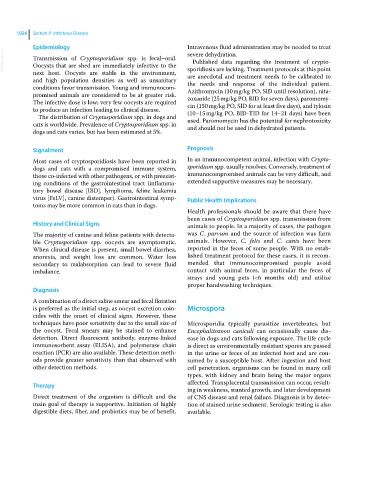Page 1088 - Clinical Small Animal Internal Medicine
P. 1088
1026 Section 9 Infectious Disease
Epidemiology Intravenous fluid administration may be needed to treat
VetBooks.ir Transmission of Cryptosporidium spp. is fecal–oral. severe dehydration.
Published data regarding the treatment of crypto-
Oocysts that are shed are immediately infective to the
next host. Oocysts are stable in the environment, sporidiosis are lacking. Treatment protocols at this point
are anecdotal and treatment needs to be calibrated to
and high population densities as well as unsanitary the needs and response of the individual patient.
conditions favor transmission. Young and immunocom- Azithromycin (10 mg/kg PO, SID until resolution), nita-
promised animals are considered to be at greater risk. zoxanide (25 mg/kg PO, BID for seven days), paromomy-
The infective dose is low; very few oocysts are required cin (150 mg/kg PO, SID for at least five days), and tylosin
to produce an infection leading to clinical disease. (10–15 mg/kg PO, BID‐TID for 14–21 days) have been
The distribution of Cryptosporidium spp. in dogs and
cats is worldwide. Prevalence of Cryptosporidium spp. in used. Paromomycin has the potential for nephrotoxicity
and should not be used in dehydrated patients.
dogs and cats varies, but has been estimated at 5%.
Signalment Prognosis
Most cases of cryptosporidiosis have been reported in In an immunocompetent animal, infection with Crypto
dogs and cats with a compromised immune system, sporidium spp. usually resolves. Conversely, treatment of
those co‐infected with other pathogens, or with preexist- immunocompromised animals can be very difficult, and
ing conditions of the gastrointestinal tract (inflamma- extended supportive measures may be necessary.
tory bowel disease [IBD], lymphoma, feline leukemia
virus [FeLV], canine distemper). Gastrointestinal symp- Public Health Implications
toms may be more common in cats than in dogs.
Health professionals should be aware that there have
been cases of Cryptosporidium spp. transmission from
History and Clinical Signs animals to people. In a majority of cases, the pathogen
The majority of canine and feline patients with detecta- was C. parvum and the source of infection was farm
ble Cryptosporidium spp. oocysts are asymptomatic. animals. However, C. felis and C. canis have been
When clinical disease is present, small bowel diarrhea, reported in the feces of some people. With no estab-
anorexia, and weight loss are common. Water loss lished treatment protocol for these cases, it is recom-
secondary to malabsorption can lead to severe fluid mended that immunocompromised people avoid
imbalance. contact with animal feces, in particular the feces of
strays and young pets (<6 months old) and utilize
proper handwashing techniques.
Diagnosis
A combination of a direct saline smear and fecal flotation
is preferred as the initial step, as oocyst excretion coin- Microspora
cides with the onset of clinical signs. However, these
techniques have poor sensitivity due to the small size of Microsporidia typically parasitize invertebrates, but
the oocyst. Fecal smears may be stained to enhance Encephalitozoon caniculi can occasionally cause dis-
detection. Direct fluorescent antibody, enzyme‐linked ease in dogs and cats following exposure. The life cycle
immunosorbent assay (ELISA), and polymerase chain is direct as environmentally resistant spores are passed
reaction (PCR) are also available. These detection meth- in the urine or feces of an infected host and are con-
ods provide greater sensitivity than that observed with sumed by a susceptible host. After ingestion and host
other detection methods. cell penetration, organisms can be found in many cell
types, with kidney and brain being the major organs
Therapy affected. Transplacental transmission can occur, result-
ing in weakness, stunted growth, and later development
Direct treatment of the organism is difficult and the of CNS disease and renal failure. Diagnosis is by detec-
main goal of therapy is supportive. Initiation of highly tion of stained urine sediment. Serologic testing is also
digestible diets, fiber, and probiotics may be of benefit. available.

